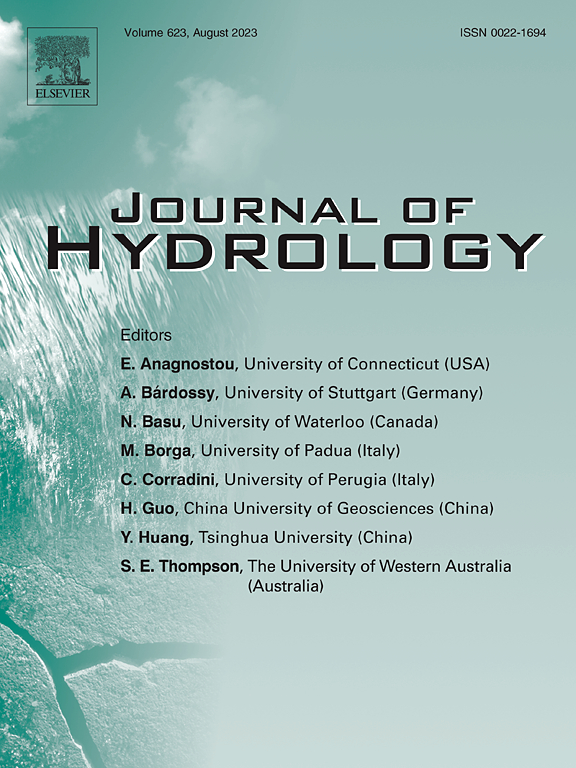东北地区水库和湖泊pCO2的季节和日变化
IF 6.3
1区 地球科学
Q1 ENGINEERING, CIVIL
引用次数: 0
摘要
内陆水体是全球碳循环的关键组成部分,但二氧化碳分压(pCO2)的时间变率给CO2通量估算带来了很大的不确定性。本研究基于2018年至2024年在中国东北6个湖泊和水库的无冰期进行的38个离散采样事件进行了分析。利用地表水中二氧化碳分压和相关水质参数的测量来评估二氧化碳分压的时间波动及其驱动因素。这些发现突出了研究区域内峡谷水库的明显季节性变化。春夏季平均pCO2水平为211 μatm,表明存在净碳汇,平均面积CO2通量(fCO2)为−5.9 mmol/m2/d。而在秋季,pCO2水平显著上升至1316 μatm,平均fCO2为42.8 mmol/m2/d,表明碳源丰富。相比之下,浅水湖泊表现出相对稳定的季节动态,在整个无冰期始终发挥大气碳汇的作用,所有季节的平均fCO2为−8.76(±3.74)mmol/m2/d。固定站点实验进一步揭示了不同季节pCO2的日变化规律,其中9月份的变化最为显著(1350 μatm)。水质参数与pCO2的相关分析表明,峡谷水库的季节差异主要是由热分层的形成和破坏驱动的。相反,浅水湖泊中较高的营养物质可用性似乎增加了大气中二氧化碳的吸收。此外,二氧化碳分压的日波动在很大程度上受太阳辐射调节的地表水光合活动的变化所控制。这些发现强调了将分层期和混合期纳入采样方案的重要性,并强调在10:00至12:00 pm之间进行测量,以提高CO2通量评估的准确性。本研究促进了对温带湖泊和水库碳循环的认识,有助于减少未来碳收支估算中的不确定性。本文章由计算机程序翻译,如有差异,请以英文原文为准。
Seasonal and diurnal variations of pCO2 from reservoirs and lakes in Northeast China
Inland water bodies serve as critical components of the global carbon cycle, yet the temporal variability of partial pressure of carbon dioxide (pCO2) introduces significant uncertainty in CO2 flux estimations. This study presents an analysis based on 38 discrete sampling events conducted between 2018 and 2024 during the ice-free period across six lakes and reservoirs in Northeast China. Measurements of pCO2 and associated water quality parameters in surface waters were used to evaluate the temporal fluctuations of pCO2 and its driving factors. The findings highlight pronounced seasonal shifts in canyon reservoirs within the study region. During spring and summer, mean pCO2 levels were recorded at 211 μatm, indicative of a net carbon sink, with an average areal CO2 flux (fCO2) of −5.9 mmol/m2/d. However, in autumn, pCO2 levels markedly increased to 1316 μatm, signifying a substantial carbon source, with an average fCO2 of 42.8 mmol/m2/d. In contrast, shallow water lakes exhibited relatively stable seasonal dynamics, consistently functioning as atmospheric carbon sinks throughout the ice-free period, with a mean fCO2 of −8.76 (±3.74) mmol/m2/d across all seasons. Fixed-site experiments further revealed distinct diurnal fluctuations in pCO2 across different seasons, with the most pronounced daily variation (1350 μatm) occurring in September within reservoirs. Correlation analyses between water quality parameters and pCO2 suggest that the seasonal differences in canyon reservoirs are primarily driven by the formation and breakdown of thermal stratification. Conversely, the higher nutrient availability in shallow water lakes appears to enhance CO2 uptake from the atmosphere. Additionally, diurnal pCO2 fluctuations are largely governed by variations in surface water photosynthetic activity, modulated by solar radiation. These findings underscore the importance of incorporating both stratified and mixed periods into sampling protocols, with an emphasis measurements between 10:00 and 12:00 pm, to improve the accuracy of CO2 flux assessments. This study advances the understanding of carbon cycling in temperate lakes and reservoirs and contributes to reducing uncertainties in future carbon budget estimations.
求助全文
通过发布文献求助,成功后即可免费获取论文全文。
去求助
来源期刊

Journal of Hydrology
地学-地球科学综合
CiteScore
11.00
自引率
12.50%
发文量
1309
审稿时长
7.5 months
期刊介绍:
The Journal of Hydrology publishes original research papers and comprehensive reviews in all the subfields of the hydrological sciences including water based management and policy issues that impact on economics and society. These comprise, but are not limited to the physical, chemical, biogeochemical, stochastic and systems aspects of surface and groundwater hydrology, hydrometeorology and hydrogeology. Relevant topics incorporating the insights and methodologies of disciplines such as climatology, water resource systems, hydraulics, agrohydrology, geomorphology, soil science, instrumentation and remote sensing, civil and environmental engineering are included. Social science perspectives on hydrological problems such as resource and ecological economics, environmental sociology, psychology and behavioural science, management and policy analysis are also invited. Multi-and interdisciplinary analyses of hydrological problems are within scope. The science published in the Journal of Hydrology is relevant to catchment scales rather than exclusively to a local scale or site.
 求助内容:
求助内容: 应助结果提醒方式:
应助结果提醒方式:


